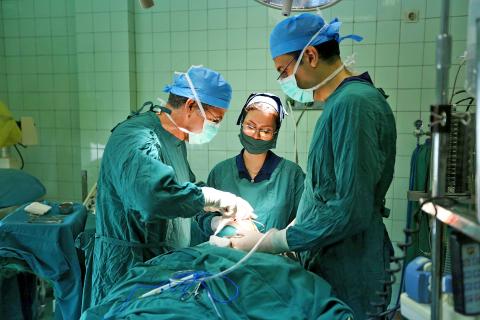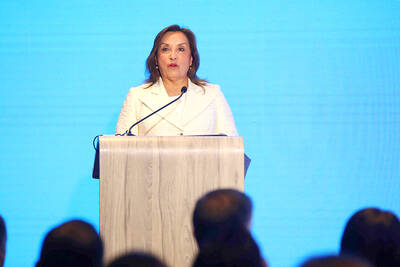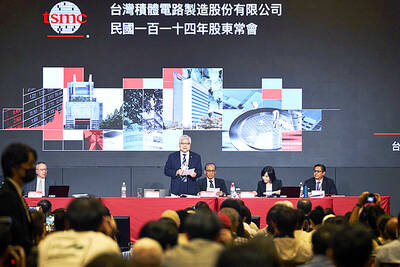Lying on an operating table in northern Tehran, Nazanine says she wants it all: a third nose job, her eyebrows tattooed and liposuction on her thighs to “fix” her figure.
The patient in her 40s “had two nose jobs with another doctor, but wasn’t happy and asked us to do it again,” says her doctor Javad Amirizad, the latest surgeon to take her under the knife.
In a conservative society where all women in public must wear at least a scarf over their hair and neck, such operations have boomed, with a nose job seen as a way to perfect their most visible asset.

Photo: AFP
However, the quest to look better goes much further: In two nearby rooms at Amirizad’s private clinic, women were having their breasts enlarged. Liposuction is another procedure on the rise and Iranian women — not just the wealthy in the capital — are also paying for less invasive cosmetic changes.
Botox injections in cheeks or foreheads to conceal wrinkles, collagen in lips to make them fuller, or eyebrow tattoos to replace painful plucking or threading — removing eyebrow hairs with a piece of string — are becoming common.
According to official figures, up to 40,000 cosmetic surgeries take place in Iran each year, says Amirizad, a member of the Iranian Association of Cosmetic and Plastic Surgeons. More than 60 percent are nose jobs.
However, he says the actual number is much higher as official statistics do not include operations by non-specialist surgeons who are cashing in on people’s desire to improve their looks.
In Iran’s largest cities it is easy to spot women — but also men — with bandages on their noses, flaunting the fact they recently went under the knife.
The trend has seen the Islamic Republic jump into the world’s top 10 countries performing plastic surgery. In 2013, it ranked fourth worldwide — after Brazil, Mexico and the US — for nose jobs, the International Society of Aesthetic Plastic Surgery reported.
The cost of a nose operation starts at around US$1,500 — more than five times the minimum Iranian monthly salary of US$270.
Mehrnaz Mehri, a 27-year-old manager at a food trading company in Tehran, says she paid closer to US$1,800, but considered it good value.
“I know some famous surgeons ask for up to US$6,000 for a simple nose job,” she says. “I never thought I’d have an operation, but when my mother and sister got their noses done, it was contagious.”
Television is playing a part is the cosmetic surgery craze.
Hugely popular South American and Turkish soap operas, beamed into homes via banned satellite dishes, show actresses looking beautiful after plastic surgery.
Such channels, watched by more than half of the population, broadcast round-the-clock advertisements for nose jobs, slimming creams and stomach-sucking corsets.
Patients also fly in for cosmetic procedures, Amirizad says.
“We get them from Iraq and Azerbaijan, but we mostly get Iranian women from abroad who know an operation is much cheaper in Iran than in the United States or other European countries,” he says.
And these days, plastic surgery is not just for women.
“Twenty years ago, about five percent of men wanted nose jobs,” the surgeon says. “Today it’s 35 percent.”
Mostafa Kashani, in his early 30s, is one of them.
“I broke my nose in an accident, and after I got married my wife insisted I get it fixed,” he says. “I refused, but then my sister had it done and it motivated me.”
Amirizad sees this as a sign of progress: “It shows our society is modernizing.”
However, some Iranians are saddened by what they see as a Western cultural trend that may be going too far.
Earlier this year, a Facebook page called “Iranian Women Up Close” asked followers to post pictures of their noses to push back against beauty being defined as a surgically enhanced concept.
Several hundred women did so under the heading “Pictures of My Natural Nose.”
Some women who have had surgery understand the debate.
Slomaz, 27, had wanted her nose redone since being a teenager and was just 20 the first time she went under the knife, but now says she would not do so again.
“Girls now all have the same type of nose — a very thin one with an upturned end like a doll,” she said.

With an approval rating of just two percent, Peruvian President Dina Boluarte might be the world’s most unpopular leader, according to pollsters. Protests greeted her rise to power 29 months ago, and have marked her entire term — joined by assorted scandals, investigations, controversies and a surge in gang violence. The 63-year-old is the target of a dozen probes, including for her alleged failure to declare gifts of luxury jewels and watches, a scandal inevitably dubbed “Rolexgate.” She is also under the microscope for a two-week undeclared absence for nose surgery — which she insists was medical, not cosmetic — and is

CAUTIOUS RECOVERY: While the manufacturing sector returned to growth amid the US-China trade truce, firms remain wary as uncertainty clouds the outlook, the CIER said The local manufacturing sector returned to expansion last month, as the official purchasing managers’ index (PMI) rose 2.1 points to 51.0, driven by a temporary easing in US-China trade tensions, the Chung-Hua Institution for Economic Research (CIER, 中華經濟研究院) said yesterday. The PMI gauges the health of the manufacturing industry, with readings above 50 indicating expansion and those below 50 signaling contraction. “Firms are not as pessimistic as they were in April, but they remain far from optimistic,” CIER president Lien Hsien-ming (連賢明) said at a news conference. The full impact of US tariff decisions is unlikely to become clear until later this month

GROWING CONCERN: Some senior Trump administration officials opposed the UAE expansion over fears that another TSMC project could jeopardize its US investment Taiwan Semiconductor Manufacturing Co (TSMC, 台積電) is evaluating building an advanced production facility in the United Arab Emirates (UAE) and has discussed the possibility with officials in US President Donald Trump’s administration, people familiar with the matter said, in a potentially major bet on the Middle East that would only come to fruition with Washington’s approval. The company has had multiple meetings in the past few months with US Special Envoy to the Middle East Steve Witkoff and officials from MGX, an influential investment vehicle overseen by the UAE president’s brother, the people said. The conversations are a continuation of talks that

CHIP DUTIES: TSMC said it voiced its concerns to Washington about tariffs, telling the US commerce department that it wants ‘fair treatment’ to protect its competitiveness Taiwan Semiconductor Manufacturing Co (TSMC, 台積電) yesterday reiterated robust business prospects for this year as strong artificial intelligence (AI) chip demand from Nvidia Corp and other customers would absorb the impacts of US tariffs. “The impact of tariffs would be indirect, as the custom tax is the importers’ responsibility, not the exporters,” TSMC chairman and chief executive officer C.C. Wei (魏哲家) said at the chipmaker’s annual shareholders’ meeting in Hsinchu City. TSMC’s business could be affected if people become reluctant to buy electronics due to inflated prices, Wei said. In addition, the chipmaker has voiced its concern to the US Department of Commerce